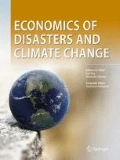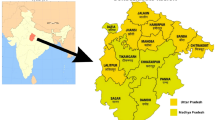Abstract
The study examines the effects of drought and flood on farmer suicides using state-level panel data from 17 Indian states for the period 1995–2011. The empirical estimates based on unconditional fixed effect Negative Binomial model show that while drought significantly increases farmer suicides, flood has no direct impact on the same. The results also show that incidence of farmer suicides is higher in cotton producing states of India because these states experience frequent drought conditions. Furthermore, our findings reveal that states with high levels of rural poverty experience a higher number of farmer suicides as a result of frequent occurrence of droughts and moderate floods. To obtain robust results, fixed effect Poisson model has been used in the study. Overall, the findings are consistent with unconditional fixed effect Negative Binomial model. Hence, in light of the results obtained by this study, it is important for the government to devise suitable policies such as loan waiver for poor farmers, compulsory crop insurance scheme, improving farm income through revamping of agricultural marketing policies, creating public awareness among farmers and providing micro-irrigation facilities as well as introducing alternative cropping pattern in the drought prone areas in order to reduce the occurrence of farmer suicides.


Similar content being viewed by others
Notes
India lost around 12% of federal revenue due to natural disasters during the period 1996–2000 (Financing Rapid Onset Natural Disaster Losses in India: A Risk Management Approach, The World Bank, August 2003, Page 8).
Author’s calculation from (http://farmer.gov.in/Drought/Droughtreport.aspx), between 2000 and 2011, 17 states experienced 69 droughts. Out of this, Tamil Nadu experienced 9 times, while Andhra Pradesh, Karnataka faced 8 times each. However, Madhya Pradesh and Maharashtra faced 7 times each. Gujarat, Himachal Pradesh, Odisha and Utter Pradesh faced 4 times each, while West Bengal and Kerala faced 2 times each and rest of states faced less than 2 times.
Employment and Unemployment reports (National Sample Survey, 38th and 68th rounds)
Here we have calculated farmer suicides per million of rural population for the period 1995 to 2011 in 17 states. The state-wise and year-wise agrarian population data is not available in India. Therefore, we have normalized farmer suicide by rural population because 64% of rural workforce depends on rural agriculture and allied sectors (68th round NSS, 2011).
At present, India has 29 states (including Telangana). Telangana state is recently formed from Andhra Pradesh in 2014. Total farmer suicides stand at 94% in the major 17 states and the remaining 6% of farmer suicides occur in rest of the states.
We estimate log linear OLS model using Eq. (1) with drought dummy. The estimates are shown in Model-3 in Table 9. The impact of drought on farmer suicides is calculated in percentage terms. The coefficient of drought dummy is 0.278 (shown in Model 3 of Table 9) and we take [exp (0.278)-1]*100 = 32.04%.
In this analysis, we have used dummy variables to indicate states producing wheat and cotton because 10 out of 17 states use 99.9% land for cotton production and 9 out of 17 states use 99.23% land for wheat production. For example, the percentage of cotton area estimated = cotton cultivated area for 10 states over total cotton cultivated area for 17 states in the year 2011 (Land Use Statistics at a Glance, 2014). Therefore, we have used the dummy variables for cotton and wheat production states instead of the area of production. The percentage figure shows that some states produce wheat and not cotton. Similarly, other states produce cotton and not wheat.
In year 2011, 83% of total cotton in India was produced by five major states namely Andhra Pradesh, Karnataka, Madhya Pradesh, Maharashtra and Gujarat. The drought prone area combining all these five states stands at 75%, while farmer suicide stands at 67% in the period 1995–2011 in these states.
See Planning Commission (2014) “Report of the Expert Group to Review the Methodology for Measurement of Poverty”, Government of India.
We have used Rural Head Count Ratio for the year 1999–2000 estimated by Lakdawala.
We have used Rural Head Count Ratio for three years such as 2004–05, 2009–10 and 2011–12 estimated by Tendulkar.
Thick rounds of Household Consumer Expenditure surveys are conducted by National Sample Survey Office (NSSO), Ministry of Statistics and Programme Implementation, GoI, within five years intervals, such as 1999, 2004, 2009 and 2011.
We have used only four rounds of Rural Head Count Ratio (RHCR) data along with drought data compiled for those years only. The data rounds used are as follows: 55th round (1999–2000) of RHCR estimated by Lakdawala and rest of the three rounds of RHCR (61st round, 2004–05; 66th round, 2009–10; 68th round, 2011–12) are estimated by Tendulkar. Total number of observations are (17 States × 4 years = 68 observations). We have matched the drought data with RHCR data available for these four years.
MGNREGS is the largest public funded program in India.
References
Allison PD, Waterman R (2002) Fixed effects negative binomial regression models. In: Stolzenberg RM (ed) Sociological methodology 2002. Basil Blackwell, Oxford, pp 247–265
Anbarci N, Escaleras M, Register CA (2005) Earthquake fatalities: the interaction of nature and political economy. J Public Econ 89(9):1907–1933
Asadi M (2000) Seed tribunal: interrogating farmers’ suicides. Econ Polit Wkly 35(43/44):3808–3810
Banerjee L (2007) Effect of flood on agricultural wages in Bangladesh: an empirical analysis. World Dev 35(11):1989–2009
Banerjee L (2010) Effects of flood on agricultural productivity in Bangladesh. Oxf Dev Stud 38(3):339–356
Basu D, Das D, Misra K (2016) Farmer suicides in India. Econ Polit Wkly 51(21):61–65
Behere PB, Behere AP (2008) Farmers’ suicide in Vidarbha region of Maharashtra state: a myth or reality? Indian J Psychiatry 50(2):124
Berry HL, Hogan A, Owen J, Rickwood D, Fragar L (2011) Climate change and farmers’ mental health: risks and responses. Asia Pac J Public Health 23(2_suppl):119S–132S
Birthal PS, Negi DS, Khan MT, Agarwal S (2015) Is Indian agriculture becoming resilient to droughts? Evidence from rice production systems. Food Policy 56:1–12
Brammer H (1990) Floods in Bangladesh: geographical background to the 1987 and 1988 floods. Geogr J 156(1):12–22
Cameron AC, Trivedi PK (1998) Regression analysis of count data. Cambridge University Press, New York, pp 282–283
Chhikara KS, Kodan AS (2013) Micro, small and medium enterprises in India: trends, composition, issues and challenges. Productivity 54(1):63–76
Dandekar A, Bhattacharya S (2017) Lives in Debt. Econ Polit Wkly 52(21):77–84
Dongre AR, Deshmukh PR (2012) Farmers’ suicides in the Vidarbha region of Maharashtra, India: a qualitative exploration of their causes. Journal of Injury and Violence Research 4(1):2–6
Escaleras M, Anbarci N, Register CA (2007) Public sector corruption and major earthquakes: a potentially deadly interaction. Public Choice 132(1):209–230
Gruere G, Sengupta D (2011) Bt cotton and farmer suicides in India: an evidence-based assessment. J Dev Stud 47(2):316–337
Guimarães P (2008) The fixed effects negative binomial model revisited. Econ Lett 99(1):63–66
Guiney R (2012) Farming suicides during the Victorian drought: 2001–2007. Aust J Rural Health 20(1):11–15
Herring RJ (2008) Whose numbers count? Probing discrepant evidence on transgenic cotton in the Warangal district of India. International Journal of Multiple Research Approaches 2(2):145–159
Hilbe JM (2012) Negative Binomial Regression, 2nd edn. Cambridge University Press, Cambridge
Jeromi PD (2007) Farmers' indebtedness and suicides: impact of agricultural trade liberalization in Kerala. Econ Polit Wkly 42(31):3241–3247
Judd F, Jackson H, Fraser C, Murray G, Robins G, Komiti A (2006) Understanding suicide in Australian farmers. Soc Psychiatry Psychiatr Epidemiol 41(1):1–10
Kahn ME (2005) The death toll from natural disasters: the role of income, geography, and institutions. Rev Econ Stat 87(2):271–284
Kellenberg DK, Mobarak AM (2008) Does rising income increase or decrease damage risk from natural disasters? J Urban Econ 63(3):788–802
Khairnar DR, Bhosale MJ, Jadhav MA (2015) Lack of irrigation facilities, drought conditions and farmers suicides in Marathwada region, India. American Journal of Rural Development 3(3):74–78
Kreft S, Eckstein D, Melchior I. Global Climate Risk Index (2017) Who suffers most from extreme weather events? Weather-related loss events in 2015 and 1996 to 2015. Germanwatch Nord-Süd Initiative eV
Loayza NV, Olaberria E, Rigolini J, Christiaensen L (2012) Natural disasters and growth: going beyond the averages. World Dev 40(7):1317–1336
Manoranjitham SD, Rajkumar AP, Thangadurai P, Prasad J, Jayakaran R, Jacob KS (2010) Risk factors for suicide in rural south India. Br J Psychiatry 196(1):26–30
Merriott D (2016) Factors associated with the farmer suicide crisis in India. Journal of Epidemiology and Global Health 6(4):217–227
Ministry of Home Affairs (2014a) Accidental deaths & suicides in India. Government of India, New Delhi
Ministry of Home Affairs (2014b) Crime In India. National crime records bureau. Government of India, New Delhi
Mishra S (2006) Farmers’ suicides in Maharashtra. Econ Polit Wkly 41(16):1538–1545
Mohanakumar S, Sharma RK (2006) Analysis of farmer suicides in Kerala. Econ Polit Wkly 41(16):1553–1558
Nagthan S, Poddar R, Kunnal IB, Basvaraja H, Banakar B (2011) A probe into socio-economic and psychological profile of farmers' suicide in Karnataka. Karnataka Journal of Agricultural Sciences 24(2):157–160
Nathan KK (2000) Characteristics of drought in Kerala, India. Water Technology Centre, http://digitalcommons.unl.edu/droughtnetnews/61/
Parida Y (2016) Economic impact of floods in Indian States. PhD Thesis. Centre for International Trade and Development, Jawaharlal Nehru University. http://www.isid.ac.in/~epu/acegd2016/papers/YashobantaParida.pdf
Parida Y (2017) Effect of flood on rural agricultural wages in indian states: an empirical analysis. Centre for International Trade and Development, Jawaharlal Nehru University, https://www.isid.ac.in/~epu/acegd2017/papers/YashobantaParida.pdf
Parthasarathy G, Shameem (1998) Suicides of cotton farmers in Andhra Pradesh: an exploratory study. Econ Polit Wkly 33(13):720–726
Planning Commission (2014) Report of the expert group to review the methodology for measurement of poverty. Government of India, New Delhi
Rajeev M, Vani BP, Bhattacharya M (2011) Nature and dimensions of farmers’ indebtedness in India and Karnataka. ISEC working paper no. 267
Rao PN, Suri KC (2006) Dimensions of agrarian distress in Andhra Pradesh. Econ Polit Wkly 41(16):1546–1552
Sadanandan A (2014) Political economy of suicide: financial reforms, credit crunches and farmer suicides in India. Journal of Developing Areas 48(4):287–307
Sarma EAS (2004) Is rural economy breaking down? Farmers' suicides in Andhra Pradesh. Econ Polit Wkly 51(21):3087–3089
Shah E (2012) A life wasted making dust: affective histories of dearth, death, debt and farmers' suicides in India. J Peasant Stud 39(5):1159–1179
Shetty PK (2004) Socio-ecological implications of pesticide use in India. Econ Polit Wkly 39(4):5261–5267
Singh A, Phadke VS, Patwardhan A (2011) Impact of drought and flood on Indian food grain production. In: Challenges and opportunities in agrometeorology. Springer Berlin, Heidelberg, pp 421–433
Smale M, Zambrano P, Gruère G, Falck-Zepeda J, Matuschke I, Horna D, Nagarajan L, Yerramareddy I, Jones H (2009) Measuring the impacts of transgenic crops in developing agriculture during the first decade: approaches, findings and future directions. Food Policy Review 10. International Food Policy Research Institute, Washington, DC
Sridhar V (2006) Why do farmers commit suicide? The case of Andhra Pradesh. Econ Polit Wkly 41(16):1559–1565
Stone GD (2011) Field versus farm in Warangal: Bt cotton, higher yields, and larger questions. World Dev 39(3):387–398
Thomas G, De Tavernier J (2017) Farmer-suicide in India: debating the role of biotechnology. Life Sciences, Society and Policy 13(8):1–21
Udmale PD, Ichikawa Y, Manandhar S, Ishidaira H, Kiem AS, Shaowei N, Panda SN (2015) How did the 2012 drought affect rural livelihoods in vulnerable areas? Empirical evidence from India. Int J Disaster Risk Reduct 13:454–469
Vaidyanathan A (2006) Farmers’ suicides and the agrarian crisis. Econ Polit Wkly 41(38):4009–4013
Wooldridge JM (2002) Econometric analysis of cross-section and panel data. MIT Press, Cambridge
Acknowledgements
We would like to thank Prof. B. N. Goldar, Mr. Jagadish Prasad Sahu, Ms. Piyali Majumder, two anonymous reviewers and Editors-in-Chief Prof. Ilan Noy for giving their valuable suggestions and comments. We thank participants at 10th Doctoral Thesis Conference, IBS Hyderabad. Any remaining errors are ours.
Author information
Authors and Affiliations
Corresponding author
Appendix
Appendix
Rights and permissions
About this article
Cite this article
Parida, Y., Dash, D.P., Bhardwaj, P. et al. Effects of Drought and Flood on Farmer Suicides in Indian States: An Empirical Analysis. EconDisCliCha 2, 159–180 (2018). https://doi.org/10.1007/s41885-018-0023-8
Received:
Accepted:
Published:
Issue Date:
DOI: https://doi.org/10.1007/s41885-018-0023-8




